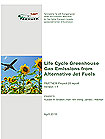
New PARTNER report compares alternative fuel GHG emissions |
PARTNER report compares alt fuel GHG emissionsMay 7, 2010 — The Partnership for AiR Transportation Noise and Emission Reduction has published a new report comparing a wide range of aviation alternative fuels’ greenhouse gas emissions throughout their entire lifecycle. The research behind the report, “Life Cycle Greenhouse Gas Emissions from Alternative Jet Fuels,” was the first to employ a consistent research methodology to examine a wide range of fuels. Key findings • Life cycle GHG emissions are but one of many considerations when evaluating the feasibility and sustainability of alternative fuel options. The study focused its research on “drop-in” alternatives that could directly replace conventional jet fuel with little or no modification to existing infrastructure and aircraft. Fuels studied included petroleum based jet fuel from conventional and unconventional sources (oil sands, and oil shale), Fisher-Tropsch fuel from natural gas, coal and biomass, and hydroprocessed jet fuels from soy oil, palm oil, rapeseed oil, jatropha oil, algae oil, and salicornia oil. Next step The researchers’ next step is to expand the project to consider additional fuels, such as those derived from pyrolysis oils and sugar fermentation. They also plan to quantify their fuel options in terms of production cost, water use impact, and production potential. The FAA’s Office of Energy and Environment sponsored the research, which was was conducted by Russ Stratton, Hsin Min Wong, and Jim Hileman at MIT as part of PARTNER’s Project 28, Environmental Cost-Benefit Analysis of Alternative Jet Fuels. FAA Chief Scientist for the Environment Dr. Lourdes Maurice said, “This report represents a critical step forward in the road to deploying alternative aviation fuels. Through this, and other projects in its portfolio, PARTNER is establishing technical leadership in the field of alternative fuel lifecycle analysis.” - Bill Litant |
Partnership for AiR Transportation Noise and Emissions Reduction
|
|
